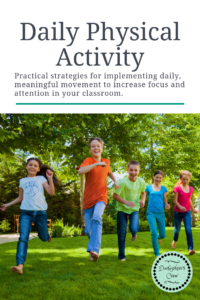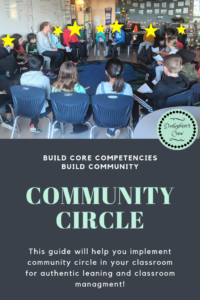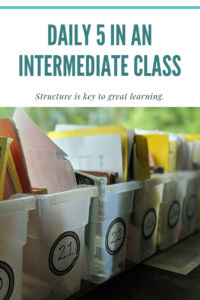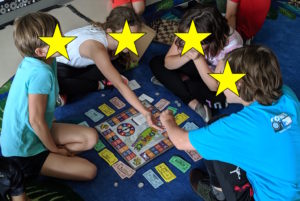 I feel like in my corner of the world, Daily Physical Activity was the catch phrase about 8 years ago. We were mandated to add a phrase to our report card that reads something like:
I feel like in my corner of the world, Daily Physical Activity was the catch phrase about 8 years ago. We were mandated to add a phrase to our report card that reads something like:
{student name} participates in Daily Physical Activity.
And we were mandated that we needed to provide at least 30 minutes of physical activity a day for OPTIMAL GROWTH and DEVELOPMENT. Wow! Most teachers lost their minds. 30 minutes in an already busy day? 30 minutes a day when I only get access to the gym for 2 40 minute blocks a week? How is it even possible?
Where does this mandate come from?
Well it comes from all the research out there that says children aged 5-16 need at least 60 minutes per day of moderate to vigorous physical activity. This is a lot of time, and not always practical for kids once they get home, so they decided that schools need to take on part of this responsibility. For a while, teachers focused on this problem and looked at solutions to how they could fit this physical activity into their day, and now as I look around the schools I’ve worked in, it amazes me how many people take this to heart and implement their Daily Physical Activity – because they see how much it helps their students with their focus, attention and learning.
If this is an area you are still struggling with or want tips and ideas for making DPA an integral part of your classroom, this is what you want to be reading! This is how I manage DPA in my classroom. I love it! My students LOVE it! And it is easy!
Exercise vs Games
First off, kids don’t seem to fully engage with ‘exercise’ like us adults would typically participate in. Yes, you can motivate them to run laps etc, and some teachers do so very successfully. But I find if I have kids do laps during our DPA time, they often just end up walking and chatting with friends. Yes, they are outside and moving, but they aren’t getting that moderate to vigorous physical activity. I want them coming back in to class huffing and puffing, exhausted from their play.
The answer is games! You know, those ones you love(d) to play. Remember when your PE teacher brought out the flags for Capture the Flag? How excited everyone was and how everyone was playing? Games challenge student’s brains with strategy, and get them moving, without them thinking they are moving. So for the best thing to do is get kids moving in a way that engages kids, rather than getting them to do activity that us adults participate in. Guaranteed, you’ll get more movement out of kids if you engage them at their level.
Structure is key!
Every day in my classroom, DPA is structured the same way. It happens, generally, at the same time of day, with the same choices of games, and with the same rules. I block 15 minutes a day in the middle of my afternoon. We do not have an afternoon recess and our afternoons are 2 hours long. I find it is incredibly difficult to expect my 10 year olds to focus for 2 hours in the afternoon. If I want any type of learning to happen that last hour in the day, I need kids to move so they stand a chance at being productive.
Structure # 1: Little to no equipment required
Over the years I have found certain games work best for this time of day. They have to involve little to no equipment. If a student has to go to the gym equipment room to gather pinnies, or hula hoops, or a ball, then DPA takes way too much out of our day. The games kids can choose from either need to have the equipment ready to go in the classroom or need to have no equipment.
Structure # 2: Set Games to Choose From & it is Student’s choice
At the beginning of the year I teach the students 4-5 games that we will play for DPA. We go over boundaries, rules, what equipment we need, etc. We problem solve any trouble spots. For instance, if there is an argument over a rule, we take the time in the classroom to find a solution that everyone can agree to. (We don’t do this on the field, kids don’t listen there and it is not conducive to a whole class discussion – kids need to take ownership over this more than I need to dictate)
An example of the types of games my students might have choice over:
- Manhunt: One or two people are ‘it’ and they need to tag everyone, once you are tagged you are it too. The larger the space the better for this game.
- Everybody’s it tag: Everyone is it and if someone tags you then you have to do something until the person who tags you is it. I make the thing they have to do a stork stand or something else active. If they are doing something inactive it defeats the purpose of DPA.

- Capture the Bean Bag: This is regularly a class favourite and students choose it probably 2-3 times out of 5 a week. Haven’t yet met a class that doesn’t love it. Download instructions on how to play (it’s free!).
- Whole class soccer: play with 2-3 balls. Just play on the field, but with 2-3 balls, everyone in the class gets involved, not just the super athletes. Goalies rotate out every 2 minutes (no one should be stationary for too long in DPA)
It is a classroom job in my class for who gets to choose the DPA game. It is usually up to a group of students and they have the job for a week. They have to work together to decide what game they should play. Some kids will even write up a schedule for the week and post it for the class. I do not give them class time to do this, they use their lunch time.
By knowing the games and rules each day, we don’t spend precious classroom time learning a new game. Students know what to expect each day and it is quick and easy to get started playing.
Structure # 3: 15 minutes is timed from when we leave the class to when we return
This is important. It makes sure that the kids choosing the game don’t wait until the last minute to decide, as that uses up their precious DPA time. The other key rule I have is when I blow the whistle to end the game, I will start walking back to the class. If I beat the kids then whoever I beat owes me 5 minutes after school. I only have to keep kids once or twice to get the habit formed that when the game is over we hustle back to class. Sometimes, for my own enjoyment, instead of walking back to class, I run. It is a truly joyful experience to watch them start sprinting to make sure they beat their teacher!
Structure # 4: Predetermined teams in the classroom
At the beginning of the year, I make 4 PE/DPA teams in the classroom. I post it so everyone knows who is on what team. When we need teams, there are teams, no muss, no fuss! If I need 2 teams for PE or DPA, then I put two of the teams together to make one. Part way through the year, I will readjust the teams if necessary, making sure all 4 are even. But otherwise the teams stay the same all year. Kids are so familiar with their teams that they don’t need pinnies for team DPA games, and life is easy!
Structure # 5: We have DPA no matter what the weather
I live in Surrey (Vancouver), Canada. It rains A LOT! And I still do DPA every day. The students and I are prepare for this. Movement is still important and fresh air is also important. If there are those days that we just can’t go out because it is so windy we will blow over and the rain is coming in sideways…. we will do an active moving activity in the classroom like a kids yoga video on youtube or something from Go Noodle. But honestly, it never has the same effect as being outside and running around.
And on those rare snowy days… well, we just go sledding. Or play in the snow. We take advantage of the snow and PLAY in it. What better DPA is there?
Generally the weather doesn’t bother the kids as much as it does me. I just make sure I have rainboots, jacket and umbrella and away we go.
DPA doesn’t have to be hard to fit in. If you can structure it in a way that makes it a seemless part of your day, it becomes easy. So easy, the teacher really doesn’t have much to do with it, other than saying, “It’s time for DPA.” And the benefits speak for themselves. Below are some links of some further reading on physical activity and the benefits for students. Both are great reads!
https://www.sciencedaily.com/releases/2009/03/090331183800.htm
♥ Cassandra
PS. Here are some other daily routines I implement in my classroom.




